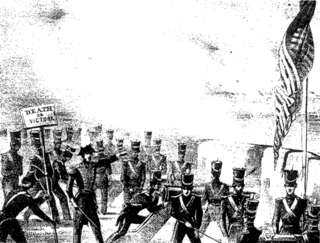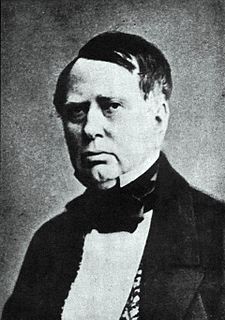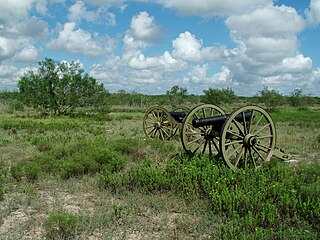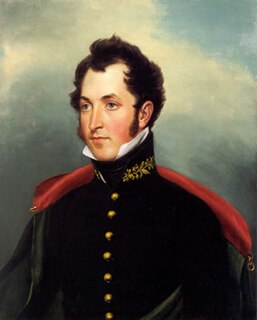
Brownsville is a city in Cameron County in the U.S. state of Texas. It is on the western Gulf Coast in South Texas, adjacent to the border with Matamoros, Mexico. The city covers 145.2 sq mi (376.066 km2), and has an estimated population of 182,781 as of 2019. It is the 131st-largest city in the United States and 18th-largest in Texas. It is part of the Matamoros–Brownsville metropolitan area. The city is known for its year-round subtropical climate, deep-water seaport, and Hispanic culture.

The Battle of Palo Alto was the first major battle of the Mexican–American War and was fought on May 8, 1846, on disputed ground five miles (8 km) from the modern-day city of Brownsville, Texas. A force of some 3,700 Mexican troops – most of the Army of The North – led by General Mariano Arista engaged a force of approximately 2,300 United States troops – the Army of Occupation led by General Zachary Taylor.

The Battle of Resaca de la Palma was one of the early engagements of the Mexican–American War, where the United States Army under General Zachary Taylor engaged the retreating forces of the Mexican Ejército del Norte under General Mariano Arista on May 9, 1846. The United States emerged victorious and forced the Mexicans out of Texas.

The Thornton Affair, also known as the Thornton Skirmish, Thornton's Defeat, or Rancho Carricitos was a battle in 1846 between the military forces of the United States and Mexico 20 miles (32 km) west upriver from Zachary Taylor's camp along the Rio Grande. The much larger Mexican force defeated the Americans in the opening of hostilities, and was the primary justification for U.S. President James K. Polk's call to Congress to declare war.

The siege of Fort Texas marked the beginning of active campaigning by the armies of the United States and Mexico during the Mexican–American War. The battle is sometimes called the siege of Fort Brown. Major Jacob Brown, not to be confused with War of 1812 General Jacob Brown, was one of the two Americans killed in action.

José Mariano Martín Buenaventura Ignacio Nepomuceno García de Arista Nuez was a noted veteran of many of Mexico's nineteenth-century wars. He served as president of Mexico from 15 January 1851 to 6 January 1853. He was the first president of Mexico to be born in the 19th century.

Pedro Nolasco Martín José María de la Candelaria Francisco Javier Ampudia y Grimarest was born in Havana, Cuba, and served Mexico as a Northern army officer for most of his life. At various points he was the governor of Tabasco, Yucatán, and Nuevo León. He also served a short term as Secretary of National Defense under President Benito Juárez.

Fort Brown was a military post of the United States Army in Cameron County, Texas during the later half of the 19th century and the early part of the 20th century. Established in 1846, it was the first United States Army military outpost of the recently annexed state. Confederate Army troops stationed there saw action during the American Civil War. In the early 20th century, it was garrisoned in relation to military activity over border conflicts with Mexico. Surviving elements of the fort were designated as a National Historic Landmark in 1960.

Palo Alto Battlefield National Historical Park near Brownsville, Texas is a National Park Service unit which preserves the grounds of the May 8, 1846, Battle of Palo Alto. It was the first major conflict in a border dispute that soon precipitated the Mexican–American War. The United States Army victory here made the invasion of Mexico possible. The historic site portrays the battle and the war, and its causes and consequences, from the perspectives of both the United States and Mexico.

Palo Alto is a place in southwestern Nueces County in the U.S. state of Texas. It is located four miles southwest of Driscoll, 7-1/2 miles north of Bishop, and 14-1/2 miles north of Kingsville.
Jean-Louis Berlandier was a French-Mexican naturalist, physician, and anthropologist.

Rómulo Díaz de la Vega was de facto president of Mexico in 1855. He studied military science and rose to the rank of general.

Samuel B. Ringgold was an artillery officer in the United States Army who was noted for several military innovations which caused him to be called the "Father of Modern Artillery." He was also, according to some records, the first U.S. officer to fall in the Mexican–American War, perishing from wounds received at the Battle of Palo Alto.

Events in the year 1846 in Mexico.

Charles Augustus May (1818–1864) was an American officer of the United States Army who served in the Mexican War and other campaigns over a 25-year career. He is best known for successfully leading a cavalry charge against Mexican artillery at the Battle of Resaca de la Palma.

The Texas Campaign was the first front in the Mexican–American War, fought between the United States and Mexico. The front started with a Mexican assault near Brownsville. US forces were forced to surrender after hours of resisting, which lead President James K. Polk to declare war on Mexico. After the United States defeated a larger Mexican Army at Palo Alto and Resaca de la Palma, Mexican Forces led by Mariano Arista retreated out of Texas.

Palo Alto Battlefield National Historic Site Act of 1991, Public Law 102-304, is a federal law, enacted on June 23, 1992, that established the Palo Alto Battlefield National Historical Site. Located in the lower Rio Grande Valley, north of modern Brownsville, Texas, the site was the location of the first battle of the Mexican–American War (1846–1848), on May 8, 1846. At the time of its establishment in 1992, Palo Alto was the first unit of the National Park Service to commemorate the Mexican–American War, a controversial conflict that ended with the American occupation of Mexico City and the cessation to the United States of Mexican lands in modern California and New Mexico.

James Duncan became a hero of the Mexican–American War for his capable command of an artillery battery at several important battles. He was a graduate of United States Military Academy in 1834 and served in the Seminole Wars. In 1848, he became involved in a post-war squabble between several general officers, though it did not harm his prospects. After his exploits in the Mexican–American War, he was appointed Inspector general of the US Army. A promising career was cut short when he died of yellow fever on an inspection tour of Mobile, Alabama in 1849.






















